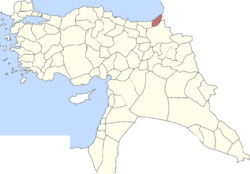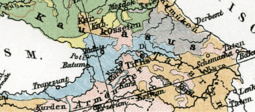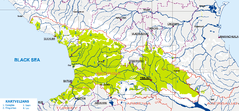Laz people
| Total population | |
|---|---|
| (45,000 to 1.6 million) | |
| Regions with significant populations | |
| 2,000[4] | |
| 160[5] | |
| Languages | |
| Laz, Georgian, Turkish | |
| Religion | |
| Sunni Islam, Georgian Orthodox[6] | |
| Related ethnic groups | |
| Mingrelians, Svans and other groups of Georgians | |
The Laz or Lazi (Laz: ლაზეფე (pl.), ლაზი (sing.); Georgian: ლაზები/ჭანები (pl.); ლაზი/ჭანი (sing.); Turkish: Lazlar, Laz;) are a Kartvelian-speaking ethnic group[7] native to the Black Sea coastal regions of Turkey and Georgia.[8]
Estimates of the total population of Laz people today ranges drastically, with numbers as low as 45,000 to as high as 1.6 million people, with the majority living in northeast Turkey. The Laz speak the Laz language, a member of the same Kartvelian (South Caucasian) language family as Georgian, Svan, and Mingrelian.[9][10] The Laz language is classified as endangered by UNESCO, with an estimated 130,000 to 150,000 speakers in 2001.[11]
History

The history of Lazica dates back to at least the 6th century BC when the first South Caucasian state in the west was the Kingdom of Colchis which covered modern western Georgia and modern Turkish provinces of Trabzon and Rize. Between the early 2nd century B.C. and the late 2nd century AD, the Kingdom of Colchis together with the neighbor countries, become an arena of long and devastating conflicts between major local powers Rome, Kingdom of Armenia and the short-lived Kingdom of Pontus. As a result of the brilliant Roman campaigns of generals Pompey and Lucullus, the Kingdom of Pontus was completely destroyed by the Romans and all its territory including Colchis, were incorporated into Roman Empire as her provinces.
The former Kingdom of Colchis was re-organized by the Romans into the province of Lazicum ruled by Roman legati. During Byzantine times, the word Colchi gave way to the term Lazica. The Roman period was marked by further Hellenization of the region in terms of language, economy and culture. For example, since the early 3rd century, Greco-Latin Philosophical Academy of Phasis (present-day Poti) was quite famous all over the Roman Empire. In the early 3rd century, newly established Roman Lazicum was given certain degree of autonomy. which by the end of the century developed into full the independence and formation of a new Kingdom of Lazica (covering the modern day regions of Abkhazia, Mingrelia, Guria and Adjaria) on the basis of smaller principalities of Svans, Apsilae, Zans and Sanigs. Lazica survived more than 250 years until in 562 AD it was absorbed by the Byzantine Empire.
The ruins of the ancient historical city-fortress of Petra are located in the village of Tsikhisdziri, Kobuleti, which dates back to the 6th century AD. Historically the territory was inhabited and belonged to the Laz people - one of the Kartvelian tribes. The Byzantine Emperor Justinian built a city here because of the importance of its unique strategic and trade-economic location. The city was crossed by the essential route connecting Western Georgia, with Byzantine provinces, Persia and Armenia.
Lazica remained a client state of the Byzantine from 522 until the arrival of the Arabs in the seventh century. In the 790s the reincorporation of Lazica with the Abkhazians ousted the Tzan-Laz from western Georgia; thereafter, the Laz lived under nominal Byzantine suzerainty in the Chaldia. with the collapse of direct Byzantine rule in eastern Anatolia after the Crusader Capture of Constantinople in 1204, the theme of Chaldia, was turned into Trebizond Empire. remaining part of the empire, mainly rural areas of this new empire appear to have been predominantly Laz in ethnic composition, the Laz monopolizing its coastal shipping and even transporting Trebizontine troops in their small craft. In the eastern part of empire, was created autonomous coastal theme of Greater Lazia,[12] theme contained lands between modern Pazar including Ardeşen and Arhavi-Hopa areas, the borders of this district remained basically identical over 300 years later.

Under the Ottoman Empire, Lazia became the Lazistan Sanjak, which existed until the end of the empire in 1923. the designation of the term of Lazistan was officially banned in 1926, by Kemalists.[13] region was divided between Rize and Artvin provinces. In 1801, the Laz living in Georgia became members of the Russian Empire and eventually became Soviet citizens after World War I.
Religion
One of the chief tribes of ancient kingdom of Colchis, the Laz were converted to Christianity while living under the Byzantine Empire and the Kingdom of Georgia. In the relatively limited territory of Empire of Trebizond there was enough room for three dioceses: Trebizond, which was the only diocese established far in the past, Cerasous and Rizaion in Lazia, both formed as upgraded bishoprics. All three dioceses survived the Ottoman conquest (1461) and generally operated until the 17th century, when the dioceses of Cerasous and Rizaion were abolished. the diocese of Rizaion and the bishopric of Of were abolished at the time due to the Islamisation of the Lazs. most of them subsequently converted to Sunni Islam.[14][15]

There are also a few Christian Laz in the Adjaria region of Georgia who have converted to Christianity.[16]
Population and geographical distribution
The total population of the Laz today is only estimated, with numbers ranging widely. The majority of Laz live in Turkey, where the national census does not record ethnic data on minor populations.[17]
The majority of the Laz today live in an area they call Laziǩa or Lazona (ლაზონა) in Northeast Turkey, in a strip of land along the shore of the Black Sea. The ancient kingdom of Colchis, and its successor, Lazica, was located in the same region the Laz speakers are found in today, and its inhabitants probably spoke an ancestral version of the language. Colchis was the setting for the famous Greek legend of Jason and the Argonauts.
The Laz are the majority in the Pazar (Atina), Ardeşen (Art'aşeni) and Fındıklı (Vitze) districts of Rize, and in the Arhavi (Ark'abi) and Hopa (Xopa) districts of Artvin. They live as minorities in the neighbouring Çamlıhemşin (Vijadibi), Borçka, and İkizdere (Xuras) districts. There are also communities in northwestern Anatolia (Karamürsel in Kocaeli, Akçakoca in Düzce, Sakarya, Zonguldak, Bartın), where many immigrants settled since the Russo-Turkish War (1877-1878), and now also in Istanbul and Ankara.
The Laz in Georgia are chiefly centered in the country's southwestern autonomous republic of Adjara. The largest Laz villages in Adjara are: Sarpi, Kvariati, Gonio and Makho. The Laz also live in Batumi, Kobuleti, Zugdidi and Tbilisi. Laz identity in Georgia has largely merged with a Georgian identity, and the meaning of "Laz" is seen as merely a regional category.[18]
Small expatriate communities of Laz are also present in Belgium, France, Germany and Russia.[4]
Culture
.jpg)
The Laz language does not have a written history, thus Turkish and Georgian serve as the main literary languages for the Laz. Their folk literature has been transmitted orally and has not been systematically recorded. The first attempts at establishing a distinct Laz cultural identity and creating a literary language based on the Arabic alphabet was made by Faik Efendisi in the 1870s, but he was soon imprisoned by the Ottoman authorities, while most of his works were destroyed. During a relative cultural autonomy granted to the minorities in the 1930s, the written Laz literature—based on the Laz script—emerged in Soviet Georgia, strongly dominated by Soviet ideology. The poet Mustafa Baniṣi spearheaded this short-lived movement, but an official standard form of the tongue was never established.[19] Since then, several attempts have been made to render the pieces of native literature in the Turkish and Georgian alphabets. A few native poets in Turkey such as Raşid Hilmi and Pehlivanoğlu have appeared later in the 20th century.
Among the Turks, the Laz have a reputation for being "fiercely independent ("Only a Laz woman can handle a Laz man," they say), quick to laugh, especially at their own expense, addicted to hawking and to carrying pistols, and they often work in construction or other building trades."[20]

The national instruments include guda (bagpipe), kemenche (spike fiddle), zurna (oboe), and doli (drum). In the 1990s and 2000s, the folk-rock musician Kâzım Koyuncu attained to significant popularity in Turkey and toured Georgia. Koyuncu, who died of cancer in 2005, was also an activist for the Laz people and has become a cultural hero. Sopho Khalvashi, a Laz singer from Georgia, was a finalist at the Eurovision Song Contest 2007.
Cultural assimilation into the Turkish and Georgian cultures has been high, and Laz identity was oppressed during the days of Ottoman and Soviet Rule. One of the pivotal moments was in 1992, when the book Laz History (Lazların tarihi) was published. The authors had failed to have it published in 1964.[21]
Over the past 20 years, there has been an upsurge of cultural activities aiming at revitalizing the Laz language, education and tradition. Koyuncu, who in 1998 became the first Laz musician to gain mainstream success, contributed significantly to the identity of the Laz people, especially among their youth.[21] The Laz Cultural Institute was founded in 1993 and the Laz Culture Association in 2008, and a Laz cultural festival was established in Gemlik.[5][22] The Laz community successfully lobbied Turkey's Education Ministry to offer Laz-language instruction in schools around the Black Sea region. In 2013, the Education Ministry added Laz as a four-year elective course for secondary students, beginning in the fifth grade.[23]
See also
| Wikimedia Commons has media related to Laz people. |
Notes
- ↑ Bülent Günal (20 December 2011). "67 milletten insanımız var!" (in Turkish). Retrieved 31 January 2015.
- ↑ "TURKEY - General Information". U.S. English Foundation Research. Retrieved 26 May 2014.
- ↑ Jak Yakar. "Ethnoarchaeology of Anatolia: Rural Socio-economy in the Bronze and Iron Ages". Institute of Archaeology. Retrieved 31 January 2015.
- 1 2 3 "Bedrohte Sprachen: Menschenrechtsreport" [Endangered Languages Human Rights Report] (PDF) (in German). 63. Society for Threatened Peoples. March 2010: 53.
- 1 2 "Национальный состав населения" [2010 Census: Ethnic composition of the population] (PDF) (in Russian). Russian Federal State Statistics Service. Retrieved 31 January 2015.
- ↑ Roger Rosen, Jeffrey Jay Foxx, The Georgian Republic, Passport Books (September 1991)
- ↑ James S. Olson (1994). Lee Brigance Pappas, Nicholas Charles Pappas, eds. An Ethnohistorical Dictionary of the Russian and Soviet Empires. Greenwood. p. 436.
- ↑ 1 Minorsky, V. "Laz." Encyclopaedia of Islam, Second Edition. Edited by: P. Bearman , Th. Bianquis , C.E . Bosworth , E. van Donzel and W.P. Heinrichs. Brill, 2010.
- ↑ Dalby, A. (2002). Language in Danger; The Loss of Linguistic Diversity and the Threat to Our Future. Columbia University Press. p. 38.
- ↑ BRAUND, D., Georgia in antiquity: a history of Colchis and Transcaucasian Iberia 550 BC – AD 562, Oxford University Press, p. 93
- ↑ "World Language Atlas". UNESCO. Retrieved 31 January 2015.
- ↑ Thys-Şenocak, Lucienne. Ottoman Women Builders. Aldershot, England: Ashgate, 2006.
- ↑ Thys-Şenocak, Lucienne. Ottoman Women Builders. Aldershot, England: Ashgate, 2006. Print.
- ↑ "Ethnoarchaeology of Anatolia: rural socio-economy in the Bronze and Iron Ages". Jak Yakar. Google Books. Retrieved 26 May 2014.
Formerly Christians, they converted to Sunni Islam a little over four centuries ago.
- ↑ Özhan Öztürk. Pontus. Genesis Yayınları. İstanbul, 2009. s. 737-38, 778
- ↑ Roger Rosen, Jeffrey Jay Foxx (September 1991) The Georgian Republic, Passport Books, Lincolnwood, IL ISBN 978-0-84429-677-7
- ↑ Silvia Kutscher (2008). "The language of the Laz in Turkey: Contact-induced language change or gradual loss?" (PDF). Turkic Languages. 12 (1). Retrieved 31 January 2015.
Due to a lack of census information on minorities (aside from a small number of exceptions such as the Greek or Armenian populations), the actual number of Laz living in Turkey can only be estimated
- ↑ Mathijs Pelkmans (2003). "Uncertain divides: religion, ethnicity, and politics in the Georgian borderlands": 174 University of Amsterdam. Retrieved 31 January 2015.
- ↑ Iksander Tsitashi (1939). Лазская литература [Laz literature]. Литературная энциклопедия (Encyclopedia of Literature) (in Russian). Moscow.
- ↑ Erla Zwingle (September 2002). "Crucible of the Gods". National Geographic. Retrieved 31 January 2015.
- 1 2 Ismail Güney Yılmaz (7 January 2015). "90'lar: Laz Kültür ve Kimlik Hareketinin Doğuşu" [1990s: The Birth of the Laz Culture and Identity Movement] (in Turkish). Lazebura. Retrieved 31 January 2015.
- ↑ Kâmil Aksoylu (3 July 2013). "Laz Kültürü Hareketi̇ 93 Süreci̇nden Laz Ensti̇tüsüne" (in Turkish). Lazca.org. Retrieved 31 January 2015.
- ↑ "Lazuri classes to begin in secondary schools in Turkey". Anadolou. 14 September 2013. Retrieved 31 January 2015.
References
- Andrews, Peter (ed.). 1989. Ethnic Groups in the Republic of Turkey. Wiesbaden: Dr. Ludwig Reichert Verlag. pp. 497–501.
- Benninghaus, Rüdiger. 1989. "The Laz: an example of multiple identification". In: Ethnic Groups in the Republic of Turkey, edited by P. Andrews.
- Bryer, Anthony. 1969. The last Laz risings and the downfall of the Pontic Derebeys, 1812–1840, Bedi Kartlisa 26. pp. 191–210.
- Hewsen, Robert H. Laz. World Culture Encyclopedia. Accessed on September 1, 2007.
- Negele, Jolyon. Turkey: Laz Minority Passive In Face Of Assimilation. Radio Free Europe/Radio Liberty. 25 June 1998
External links
- Laz Culture Association (Turkish)
- Lazca.org: Culture, News and Information (Turkish)
- Lazebura.com: Culture, News and Information (Turkish)
- Lazuri.com: Culture Portal (Turkish)

